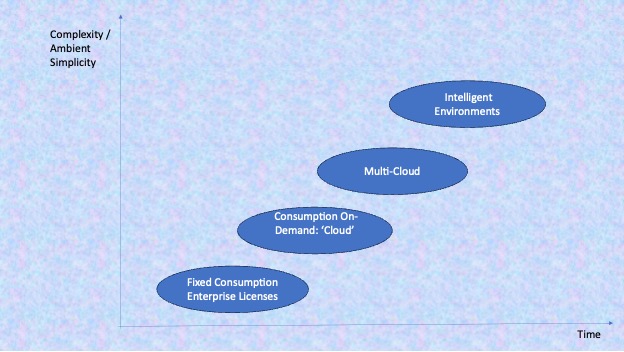
By Brice Ominski, CITA-D, Chief Architect, Global Chief Technology Officer, Deep Dive World
Overview
IT architecture has evolved through several distinct epochs that supported the evolution of business technology. This business technology shift is more than a “consumption gap … the idea that technology companies can add features and complexity to their products much faster than consumers can consume them.”[1] Indeed, we have seen a trend that argues that increased technology results in improved flexibility and intuitive product use. As Steve Jobs said, “Simple can be harder than complex: You must work hard to get your thinking clean to make it simple. But it’s worth it in the end because once you get there, you can move mountains.”[2] As business technology evolves, it delivers simplicity with more flexible consumption models that support building a more intuitive and contextual end-user experience. The architectural skills that support this evolution are also changing. This article discusses how those IT architecture skills are evolving. It suggests how the architecture toolkit for the future is also evolving so that we can continue to evolve technologies that “can make life easier … [we] touch the right people. [with] things [that] can profoundly influence life.” [3]
This evolutionary transition, illustrated in Figure 1, highlights the critical role of Consumption and business models in realizing technology’s value. By understanding past trends and anticipating future shifts, IT architects can better align their strategies with consumer expectations and business goals, ensuring that technology continues to serve as a pivotal driver of Innovation and growth in an era of Intelligent Environments[4].
Figure 1 Consumption Epochs

Let’s review this transition at each epoch and what that means to the delivery of enterprise architecture.
Fixed Consumption: The Enterprise License Agreement
The early adoption of IT by businesses (in the late 90s and early 2000s) focused on how businesses could use computer technology to improve efficiency, drive growth, and adapt to a rapidly changing landscape. Optimized processes and laid the groundwork for the more dynamic and flexible IT consumption models that would follow. IT architecture necessarily focuses on detailed upfront specifications needed to support the delivery of large projects.
Figure 2 Fixed Consumption
| Business
|
The business delivers large IT projects and infrastructure with predictable costs aligned to the business’s capabilities. IT primarily delivered critical support, including data processing and management, automated accounting, supply chain management, and the Automation of many other business services.
|
| Consumption Model
|
Fixed Consumption is tied to the enterprise licensing agreements. Initially, businesses primarily engaged in capex models, making significant upfront investments in IT infrastructure and software through ELAs. This model required large, one-time payments, leading to a focus on long-term ROI and often resulted in over-provisioning to ensure capacity for future growth.
|
| End User View
|
Siloed, rigid, and non-intuitive systems of limited scale support and automate business functions by providing increasingly more functions and capabilities, i.e. increasing the capability gap between what products are delivered and what users can understand and use on a routine basis. |
| Architectural Focus
|
Architecture focuses on the creation of detailed specifications and rigorous preplanning and risk management due to high upfront investment costs.
Capacity planning: Skills in forecasting and planning for future capacity needs based on fixed resources and the need to anticipate requirements for upcoming large projects. Technical Depth: Deep knowledge of specific technologies and platforms to optimize performance and ensure compatibility. Vendor architects often augment project teams to provide deep product expertise. |
Consumption on Demand: Cloud Computing
The transition towards cloud-based, on-demand service delivery models represents a pivotal evolution in business strategy and IT architecture, driven by a profound shift in consumer expectations for immediacy, flexibility, and personalization. This era has heralded a significant change in how services are consumed and marked a strategic financial shift from Capex to Opex, enabling businesses to become nimbler financially and strategically. Technologies such as API management, Service-Oriented Architecture (SOA), and hybrid integration platforms have been instrumental in this transition. Integration architecture has also kept pace by using increasingly sophisticated patterns, frameworks, and platforms.
Figure 3 Consumption on Demand
| Business
|
On-demand consumption models (i.e. cloud) shift business value realization from Capex to Opex. IT vendors that adopt pay-as-you-go costing, can introduce a diverse range of business models that better leverage IT. |
| Consumption Model
|
Cloud computing emphasizes Opex costing, allowing businesses to pay for IT services based on Consumption or adopt a hybrid approach that shares Capex and Opex IT expenses. Organizations now scale resources up or down as needed, aligning costs directly with actual usage and reducing the need for significant upfront investments. IT businesses also innovate more freely and address challenges in cost management and risk by displacing them with pay-as-you-go pricing models.
|
| End User View
|
On-demand access to various applications and services and more flexible pricing models.
|
| Architectural Focus
|
Introduce native cloud architectures (IaaS, PaaS, and SaaS), including microservices, serverless, and containers—security focus.
Digital Innovation focuses on experimentation, starting with minimum viable products and using agile methods to expand functionality based on feedback. DevOps and Automation streamline the deployment and management of applications.
|
The Multi-Cloud: Business Ecosystems
As we progressed into the multi-cloud era, the emphasis on ecosystem integration, strategic flexibility, advanced data analytics, and AI capabilities came to the forefront. This stage is characterized by cross-cloud fluidity and enhanced collaboration, offering a simplified user experience by abstracting the complexity of underlying cloud infrastructures. For architects, this means creating interoperable cloud services, decentralized and autonomous systems, and integrating edge computing.
Figure 4 multi-cloud
| Business
|
Business looks to play a role in larger ecosystems and larger potential markets. While digital technology has become more integrated with business models, paradoxically, the ability to provide core IT services is becoming more commoditized and affordable.
|
| Consumption Model
|
The new consumption model provided greater financial flexibility and agility, enabling businesses to experiment and innovate more freely. However, it also introduced cost management and optimization challenges, necessitating sophisticated cloud governance.
|
| End User View
|
On-demand flexible access to an increasing variety of applications and services with pay-as-you-go and access to killer applications. The adoption of cloud services has become commoditized.
|
| Architectural Focus
|
Focus on Interoperability and integration across cloud services.
Early integration and interoperability technologies, including platforms, gateways, master data management, and a greater focus on semantic compatibility[5]. This approach opens opportunities for more significant Innovation and new business models.
|
Intelligent Environments: The Near Future of IT Architecture
Entering the phase of intelligent environments, we encounter a paradigm where technology is seamlessly integrated into every facet of business and society, driven by real-time decision-making, personalized customer experiences, and automated operations. This era is defined by pervasive computing, advanced AI and machine learning, and the seamless integration of digital and physical worlds. Architectural focus extends to adaptive business models, seamless ecosystem integration, sustainability, and ethical governance.
Figure 5 Intelligent Environments
| Business
|
Business opportunities based on integrated digital-physical experiences, hyper-personalization, and immersive environments with security and privacy.
|
| Consumption Model
|
Based on end-user participation, The move towards intelligent environments is characterized by the seamless introduction of digital worlds to our ambient space. Advanced technologies like AI and IoT support it. |
| End User View
|
It has merged the ambient environment with virtual reality, augmented reality, and intelligence to create a truly immersive experience. As Steve Jobs would have approved, the end-user experience has integrated into their environment, making use simple and intuitive.
|
| Architectural Focus
|
Architectures support intelligent environments using augmented reality, seamless integration, and pervasive computing with increasing use of ontologies[6] and other integrating technologies.
Architectural practices leverage communities of practice to share learnings and experiences. As technology shifts more rapidly than ever, companies will outsource professional skills to communities of interest (like what we see in Medicine and other professions) focusing on other emerging methods like Quantum, Neuromorphic computing, and generative AI.
|
Conclusion
In this transformative journey, IT architecture has not only adapted to the changing landscape of technology consumption but has also played a pivotal role in driving business value, simplifying the user experience, and fostering Innovation. The roadmap ahead is paved with opportunities for architects to leverage emerging technologies and methodologies, ensuring that our world is built on the foundations of Interoperability, adaptability, and Innovation.
About Brice
With over 30 years of experience in the IT industry, Brice is a seasoned and certified IT architecture leader who drives innovation and transformation at iRangers International Inc., a global IT consulting firm. As the Chief Technology Officer, he oversees the strategic direction, development, and delivery of cutting-edge IT solutions that help his clients achieve their business goals and optimize their performance.
Brice is passionate about building and leading high-performing teams, establishing trust and connections with senior executives and stakeholders, and delivering exceptional business value. He has a proven track record of successfully managing complex and large-scale IT projects, consulting on IT strategy and best practices, and applying his expertise in information systems, intelligent systems, and international business finance and innovation working for organizations including Deep Dive World, iRangers, Manitoba Public Insurance, University of Manitoba, MNP, Microsoft, IBM and Price Waterhouse.
[1] The consumption gap between what products deliver as they evolve versus what consumers can use, the authors argue has been increasing out of control and in many senses is leading to a complexity avalanche, J.B Wood, Todd Hewlin, and Thomas Lah, Consumption Economics, The New Rules of Tech (Book Masters Kindle Edition ©2011), 148.
[2] Steve Jobs on why simple is harder than more complex.
[3] Steve Jobs on the goal of technology.
[4] “Intelligent environments” cover ambient intelligence, and pervasive computing to augmented living by delivering computers that are intuitively easy to use and fit in the end users’ environment.
[5] Semantic interoperability is about ensuring that when data is shared among systems, the full meaning of that data is understood and maintained, facilitating better collaboration, innovation, and efficiency across those systems.
[6] An ontology is a structured framework that categorizes and defines the relationships among a set of concepts within a specific domain, facilitating clear communication and data interoperability. It serves as a foundational element for semantic web technologies, artificial intelligence, and data integration, enabling diverse systems to understand and process shared information consistently.
